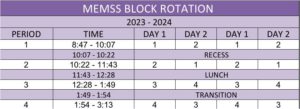IF you have concerns at School and do not know how the system works, CMSD82 has a guide to walk you through the steps. Please see the steps below to work together to resolve the problem:
Meet with the teacher
1. Have a positive attitude – be assertive 5. Agree on a solution
2. Take an objective approach 6. Who will do what? When?
3. Be Cooperative 7. When to review? Meet again
4. Agree on what the problem is 8. Keep notes – keep a log
What to do if you still have a concern? (The next step)
1. Inform the teacher that you do not 6. Take a friend for support
think the problem is resolved 7. Present position
2. Meet with the Principal 8. State what you would like to see happen
3. State the problem 9. Agree to action and/or next meeting
4. List the steps already taken 10. Keep notes
5. Write your questions down 11. Within a week, send confirming letter
What if you still have a concern?
Inform the principal that you are filing an appeal and ask about the procedures
Meet with the next level of authority on the chain of command, as follows:
Coast Mountains SD82 Chain of Command
http://www.cmsd82.bc.ca
Toll-free 1-800-665-6134
Dealing with Problems:
- Discuss the problem with the person involved: eg., teacher. Problems are often solved here.
- Discuss the problem with the Vice Principal/Principal.
- Discuss the problem with the person next in authority, the Director of Instruction for Student Support Services, Toll Free 1-800-665-6134
- Discuss the problem with the person next in authority. That person may be the Superintendent or Superintendent of Schools
- Students or parents may appeal.
APPEALS – The appeals process is a right for parents in the School Act. Families should weigh all their options and exhaust all efforts with District Staff before proceeding to an appeal.
Tips on Preparing an Appeal
1.. Request a copy of the appeal policy from your school district. This policy will outline the procedure and timelines for each step of the appeal. It will also tell you when to expect a decision from the board. The board’s decision should be in writing. (see appeals form link below)
2. Ask who will be in attendance at the meeting and what their roles are.
3. You must support the issue you’re appealing with written documentation, including relevant policies or legislation that apply to your case. You must submit this documentation to the Board of Education as part of your appeal application.
4. You’re entitled to any Board of Education records relevant to the decision you’re appealing, and to get copies of all written documentation that the Board of Education will use at the appeal hearing.
5. Seek an advocate’s support to help you prepare and accompany you at the formal appeal.
6. Work with your advocate to prepare your argument carefully. Your advocate can help you find examples of similar situations to support your case.
7. In some cases, it may help to have your child present, although the board may deny this request. If so, you may want to bring a photograph.
8. The Board of Education decision is binding and is the final step for resolution with your school district. If you believe that the appeal process wasn’t fair or that proper procedure wasn’t followed, you can research other options. To investigate other options outside the school system, please contact the Ombudsman’s office or see www.ombud.gov.bc.ca. For information to file a human rights complaint, see the B.C. Human Right Tribunal website at www.bchrt.bc.ca.





